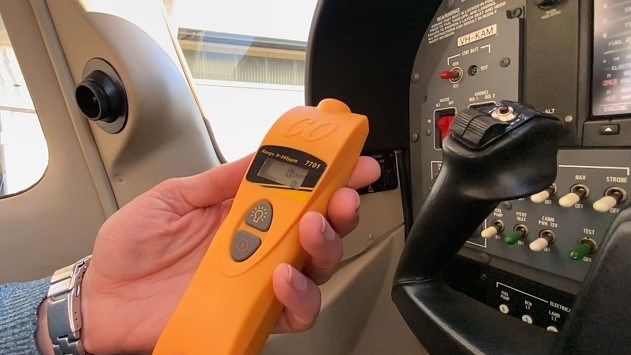
An exemplar active CO detector. Passive spot detectors have known limitations
|
Key points:
|
The Australian Transport Safety Bureau (ATSB) is again urging operators and owners of piston-engine aircraft to use an active warning carbon monoxide detector, following the partial incapacitation of the pilot of a Piper PA-28 light aircraft near Moree last year.
Shortly after take-off from Moree on 23 September 2020, the pilot began feeling unwell, experiencing a warm feeling in their chest, dizziness, breathlessness, some confusion and disorientation.
The pilot then noticed a discolouration of the cabin’s disposable carbon monoxide (CO) spot detector, which rapidly darkened. They immediately returned to the airport, reduced engine power and opened all the fresh air vents and the side window.
After a safe landing, the pilot was taken to hospital where their carboxyhaemoglobin level was recorded as being mildly elevated. The pilot was given supplemental oxygen, and began feeling better after about 2 hours.
After the incident, engineers conducted ground runs on the aircraft, which confirmed CO was leaking into the cabin, with a new disposable CO spot detector also showing discolouration. Further inspection revealed 4-5 pinholes in the exhaust stack that were not covered properly, and unserviceable scat (air duct) hoses. Upon repairing the pinholes and replacing the scat hoses, ground runs found no indication of CO in the cabin.
“The positive indications on two separate disposable CO spot detectors, both during the flight and during ground runs afterwards, indicated that the pilot was likely exposed to elevated levels of CO in the aircraft cabin,” said ATSB acting Director Transport Safety Kerri Hughes.
“CO is a colourless and odourless gas, and its presence may not be detected until the physical symptoms and cognitive effects present themselves.”
Ms Hughes noted that, while in this incident the disposable spot detector was effective in warning the pilot of the presence of CO, they do have known limitations.
“Although commonly used in general aviation, a spot detector is a passive device that relies on the pilot regularly monitoring it for discolouration.
“In addition, identifying a positive indication is also dependent on the detector being easily visible and accessible.”
In 2020, the ATSB highlighted its concerns regarding exposure to CO when it issued two Safety Advisory Notices arising from its investigation into the collision with water of a DHC-2 Beaver aircraft in Jerusalem Bay, north of Sydney on 31 December 2017, in which the pilot and five passengers were fatally injured. Toxicological testing of blood samples found the pilot and two passengers had elevated levels of CO. The aircraft was fitted with a disposable CO spot detector.
The first Safety Advisory Notice, to maintainers of piston-engine aircraft, highlighted the importance of the thorough inspection of exhaust systems and the timely repair or replacement of deteriorated components.
The second Safety Advisory Notice, to piston-engine aircraft owners and pilots, reiterated the importance of the use of an active CO detector in the cabin.
“The ATSB strongly encourages owners and operators of piston-engine aircraft to use a CO detector with an active warning,” said Ms Hughes.
“These devices are inexpensive and widely available, and they provide pilots with the best opportunity to detect CO exposure before it adversely affects their ability to control the aircraft, or they become incapacitated.”
Read the report: Partial pilot incapacitation involving Piper PA-28, VH-TBB, 19 km south-east of Moree, New South Wales, on 23 September 2020


